#taung
Explore tagged Tumblr posts
Text
Greetings everyone
And "Su'cuy'gar" to all Mandalorian fans….This is my first post here on this site.
I'm a VERY big fan of The Taung, The Mythosaur, Mandalorians, The Resol'nare, The SuperCommando Codex, Jaster Mereel, True Mandalorians, Jango/Boba Fett, The The Cuy'val Dar, Mandalorian Protectors, Mandalorian SuperCommandos, Clones, Alpha-Class ARC Troopers, Null-Class ARC Troopers, Kal Skirata, Clone Commandos, Phase-I Armored Clone Troopers, Phase-I Clone Trooper Armor, All associated Clone Trooper Weapons, Vehicles, Ships, Mandalorian Helmets, Mandalorian Armor, Mandalorian Armor Technology, Mandalorian Arm Gauntlets, All associated Mando Weapons, Vehicles, Ships, Planets, Characters & all Star Wars Armor.
(I also like ALIEN(s), Predator, RoboCop, Terminator, OG BattleStar Galactica & Sci-Fi, Blade (Daywalker), Batman, Video Games, Toons, Comix, Movies, & Animation.)
Also interested in: Armor, Armored Helmets, Helmet Cutaways, Helmet Interiors, Helmet Faceplates, Helmet Faceplate Interiors, Helmet Heads-Up Displays, Heads-Up Display (HUD), Heads-Up Displays (HUD's), HUD (Heads-Up Display), HUD's (Heads-Up Displays), Data Read-Out Displays, Data Read-Outs, Graphic User Interface (GUI), Graphic User Interfaces (GUI's), UI (User Interface) UI's (User Interfaces), Pictures, Blueprints, Charts, Diagrams, Schematics, Drawings, Technical Drawings, Mechanical Drawings, Industrial Designs, Cross Sections, Cutaways, Cutaway Views & Exploded Views.
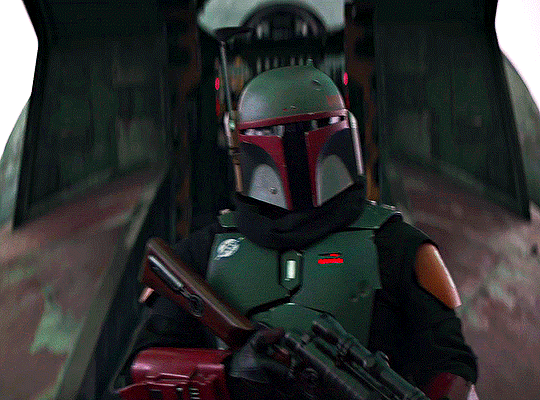
#star wars#taung#mandalorians#jaster mereel#jango fett#boba fett#mandalorian armor#beskar#beskar’gam#star wars armor#heads-up displays#data read-outs#mandalorian protectors#mandalorian supercommandos#true mandalorians#mandalorian armor technology#mandalorian technology#mandalorian wrist gauntlets#mandalorian helmet technology
166 notes
·
View notes
Text

Mandalorian Uniforms
Top Row:
Taung Shadow Warrior
Crusader
Neo-Crusader
Death Watchman (Civil War)
Death Watchman (Clone Wars)
Nite Owl
Shadow Commando (Maul's Supercommando)
Bottom Row:
Journeyman Protector
True Mandalorian (Jango's Supercommando)
New Mandalorian Guard
New Mandalorian Royal Guard
Protector (Clone Wars)
Protector (Imperial Period)
Protector (post-Endor)
My lore series on Jango Fett
#pixel art#star wars#sw legends#fanart#mandalorian culture#mandalorians#jango fett#mandalore#taung#shadow warriors#new mandalorians#true mandalorians#death watch#nite owl#mandalorian protectors
9 notes
·
View notes
Text



Mandalore the Ultimate in Star Wars: Tales of the Jedi - The Sith War (Published 1995-1996)
#mandalore the ultimate#OR IS IT. (i tend to believe yes. but that would be fun to explore some time now i've said that...)#tales of the jedi#tales of the jedi the sith war#taung#mandalorians#totj#mandalorian lore#te ani'la mand'alor#feels cheeky to tag this with#kotor#but that's where all my other neo-crusader stuff is sorry#now 'is that his face or a helmet'. whole other post.#my post#Great sith war
29 notes
·
View notes
Text
blood upon my brow
Fandom: Star Wars, Prequel Trilogy, Jango Fett Open Seasons, Tales of the Jedi,
Chapter: 2/?
Rating: Mature
Warnings: Graphic Depictions of Violence
Relationships: Jaster Mereel/Original Character, Jaster Mereel/Original Alien Character, Original Character & Arla Fett & Pre Vizsla, Arla Fett & Pre Vizsla
Characters: Original Alien Character, Original Taung Character, Original Mandalorian Characters, Jaster Mereel, Pre Vizsla, Arla Fett, Jango Fett, Darksaber | Tarre Vizsla's Lightsaber, Tarre Vizsla, Darth Maul, Kilindi Matako, Obi-Wan Kenobi, Gar Saxon
Additional Tags: Canon Divergence, Mandalorian Civil War | Death Watch vs Jaster Mereel's True Mandalorians, Jaster Mereel Lives, Protective Jaster Mereel, Taung Species, Mandalorian Culture & Customs, Alien Culture & Customs, Mando'a Language, Nonbinary Character, Mandalorian Adoption, Mandalorian Jedi, Found Family, Jedi Culture & Customs, Past Child Abuse (bc Tor Vizsla and Palpatine, etc.), PTSD
Summary:
Everyone knows that the original Taung Mandalorians have been extinct for thousands of years.
Then, during the height of the conflict between Kyr'tsad and the Haat Mando'ade, a Taung warrior appears bearing both beskad and jetii'kad. And in their wake, a gaggle of fiercely loyal (and terrifyingly feral) ade follow.
It's little wonder that Jaster ends up falling buy'ce over boots for them.
#taung#star wars#jaster mereel#true mandalorians#star wars fanfiction#ossus#arla fett#pre vizsla#darth maul#obi-wan kenobi#taung mandalorians#cross talks#my fic
10 notes
·
View notes
Text

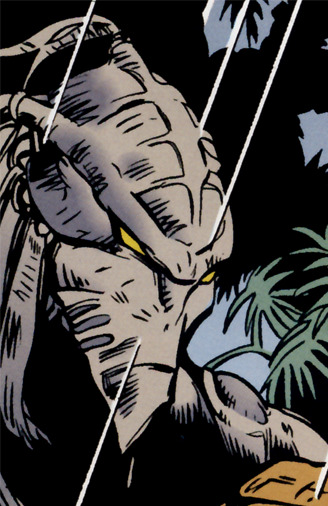

Taung appreciation post
Manda’lor the ultimate
#mandalorian culture#mandalorians#mandalorian#star wars eu#star wars expanded universe#Manda’lor the ultimate#taung#mandalor#manda’lor
47 notes
·
View notes
Note
Okay I gotta ask about 'What the Kriff do you want' that just made me laugh. Hilarious WIP title.
YES! I was hoping someone would ask about this one!
It's a prequel to "What The Force Wants". It follows the Taung evacuation of Coruscant. Or at least this one clan of Taung, they crash land on a primitive inhabited planet (of an alien species of my own creation) leaving a fraction of the clan alive. Ora'Ore, a Taung who has just recently reached majority, was injured in the crash leaving him partially blind.
Enter Diinal the daughter of the tribe's leaders. She is fascinated by the Taung and goes out of her way to involve herself in their daily activities, despite the vast language barrier.
Ora'Ore wants nothing to do with her, she reminds him too much of the zhell in her appearance. Even though the other Taung have no such issue. (it's the first red flag of blindness affecting him) Diinal refuses to leave him alone.
No matter what Ora'Ore does she comes back. "What the kriff do you want?" is what he asks every time he sees her approach him.
5 notes
·
View notes
Text

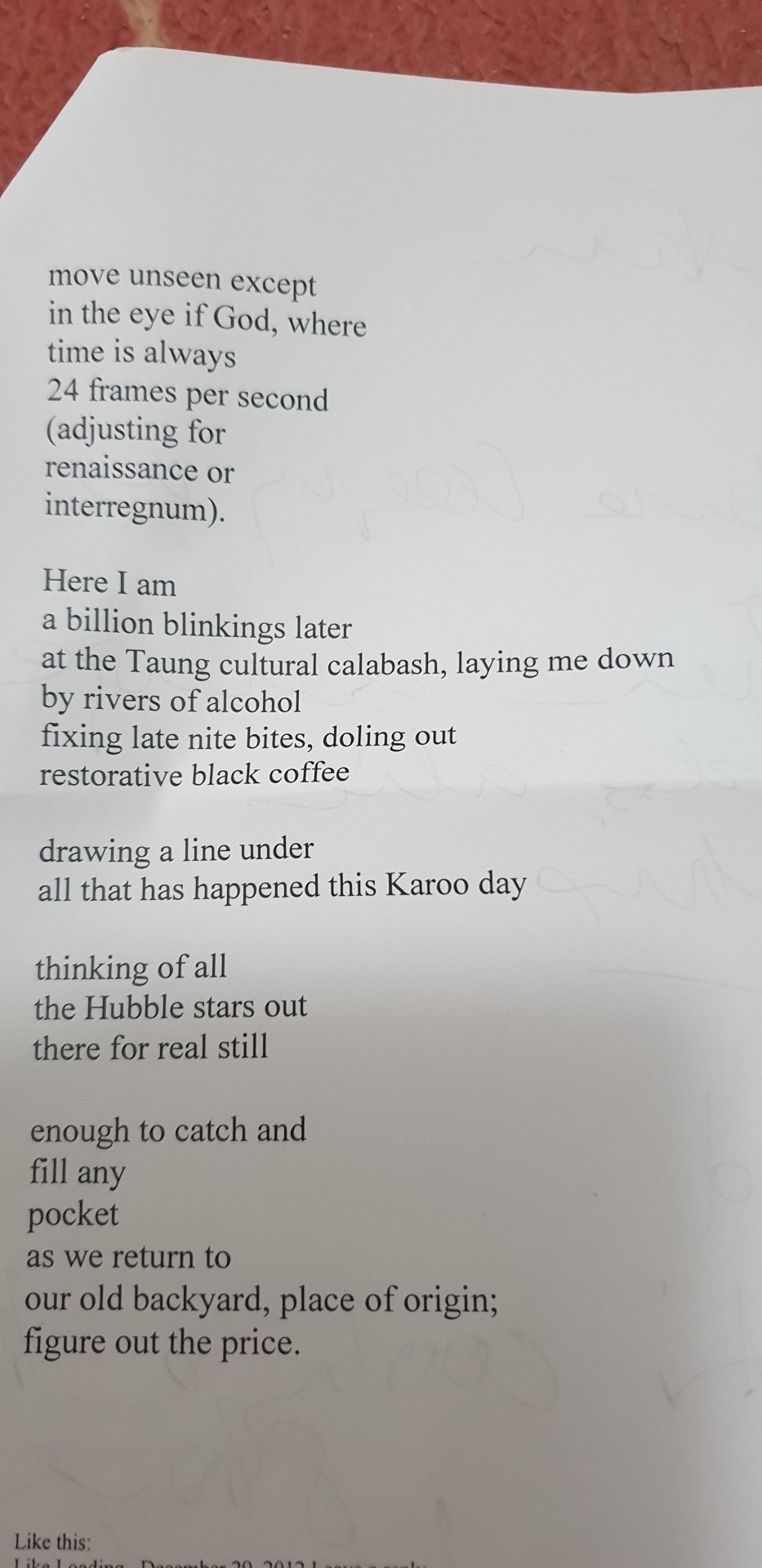
2 notes
·
View notes
Text
Cienie's take on Mandalorian Culture: Arasuum, the God of Death, not Sloth #3
The Funeral Rites of Taungs and later Mandalorian Warriors. <> Kad Ha’rangir and Mandalorian traditional weapons (part 1 — part 2 — part 3 – part 4 – part 5) <> Arasuum, the God of Death, not Sloth (part 1 — part 2 — part 3 — part 4)
Mandalorians: People and Culture was written as a handy guide - as I was proving in the previous part, some elements of the mentioned article do not fit well with widely understood Legends lore. I dare to say, it was never perfect source material even back in 2006, but it is still an important piece overall and the origin of Arasuum presented as a sloth god, albeit with no further details about the Mandalorian creation tale.
Chronologically wise, the next source material expanding our knowledge about Mandalorian mythology and religion comes from The Essential Guide to Warfare, written by Jason Fry and Paul R. Urquhart and published in 2012. In contrast to Mandalorians: People and Culture, this source book presented vital information about Mandalorian history in the form of in-universe academic text: Excerpted from “Industry. Honor. Savagery: Shaping the Mandalorian Soul” keynote address by Vilnau Teupt, 412th Proceedings of Galactic Anthropology and History, Brentaat Academy, 24 ABY
From the formal description alone we can establish some potentially additional context. Like:
⤿Brentaat is one of Core Worlds and as such was part of the Empire. This is an important detail as we need to remember that the imperial education system was pro-human and thus incredibly biased against alien cultures. As the Empire lasted more than 20 years (19BBY - 4ABY), we can’t cross out the possibility that some falsified history or, alternatively, deliberately concealed data influenced the current state of academic knowledge as at least one or two generations of human and similarly long living humanoid researchers earned their grades and academic titles under the Galactic Empire’s regime - a regime that was responsible for vast numbers of genocides and intentional destruction of non-human cultures but also everyone opposing Palpatine’s rule. Because of that, there is a great chance that modern scholars:
unconsciously based their academic research on incorrect data or
had no chance to examine the original written sources and archaeological finds because those were irretrievably destroyed or suitably hidden during the Empire era. Like what happened with Jedi Archives (available to scientists from various fields during the Republic era, confiscated by Emperor Palpatine) or Aldeeraan and Mandalore (intentional destruction of the planets).
⤿the “412th Proceedings of Galactic Anthropology and History, Brentaat Academy, 24 ABY” suggests a long academic tradition. Even if the recurring event continued through the Empire era, its roots date back to the times of the Old Republic. However, as mentioned above, two decades is enough time to influence academic environment.
⤿ the academic text was presented after Empire Fall. If we look at timeline from the perspective of Legends, the proceeding happened about a year before Yuzhaan Vong Invasion and after many political conflict between New Republic and Imperial Remnants. If we go with Disney New Canon, then Mandalore should be already rediscovered and recolonised after imperial genocide of the Mandalorian people (as seen in The Mandalorian TV series). In the case of the latter, it would make sense for the author to “celebrate” renewal of almost destroyed culture especially as a keynote address during an academic event dedicated to anthropology.
“Industry. Honor. Savagery: Shaping the Mandalorian Soul” discusses the period of time from Taungs leaving ancient Coruscant to the Clone Wars era (understandably not addressing the events from the final The Clone Wars season which aired in 2020). And so we have:
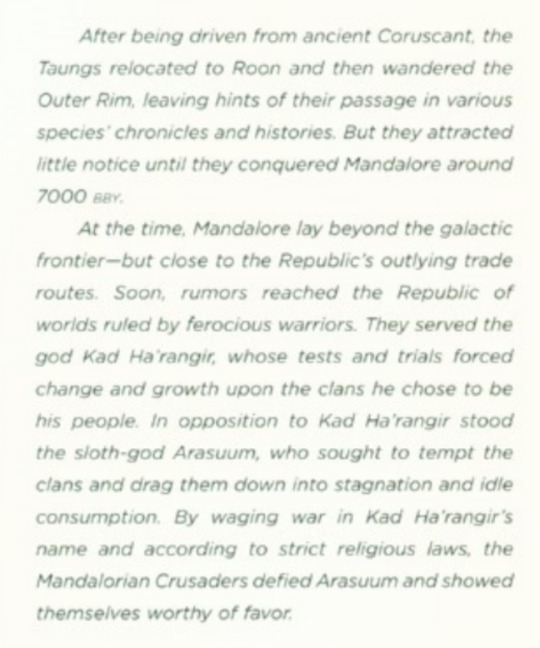
“After being driven from ancient Coruscant, the Taungs relocated to Roon and then wandered the Outer Rim, leaving hints of their passage in various species’ chronicles and histories. But they attracted little notice until they conquered Mandalore around 7000 BBY. At that time Mandalore lay beyond the galactic frontier - but close to the Republic’s outlying trade routes. Soon, rumors reached the Republic of worlds ruled by ferocious warriors. They served the god Kad Ha’rangir, whose tests and trials forced change and growth upon clans he chose to be his people. In opposition to Kad Ha’rangir stood the sloth-god Arasuum, who sought to tempt the clans and drag them down into stagnation and idle consumption. By waging war in Kad Ha’rangir’s name and according to strict religious laws, the Mandalorian Crusaders defied Arasuum and showed themselves worthy of favor.”
As Vilnau Teupt pointed out, the first information about Mandalorians and their religion reached the Republic in the form of rumors. Author does not specifically point out who brought such information, but we can assume the news travelled with the traders, smugglers or brave adventurers who for some reason wandered beyond Republic’s outlying trade routes. We have no idea if those people met in person with Mandalorian warriors (thus retelling their personal experience) or did pass second-handed information coming from the mentioned conquered worlds. This is especially interesting, as previously established lore suggested that Taungs (early Mandalorians) were rather set on whole destruction of those who weren’t able defeat them in the battle:
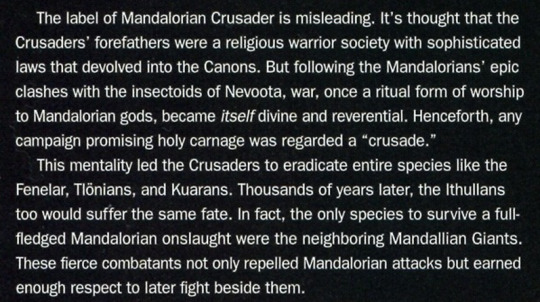
“The label of Mandalorian Crusader is misleading. It’s thought that the Crusaders’ forefathers were a religious warrior society with sophisticated laws that devolved into the Canons. But following the Mandalorians’ epic clashes with insectoids of Nevoota, war, once a ritual form of worship to Mandalorian gods, became itself divine and reverential. Henceforth, any campaign promising a holy carnage was regarded a “crusade”. This mentality led the Crusaders to eradicate entire species like the Fenelar, Tlӧnians, and Kuarans. Thousands of years later, the Ithullans too would suffer the same fate. In fact, the only species to survive a full-fledged Mandalorian onslaught were the neighboring Mandallian Giants. These fierce combatants not only repelled Mandalorian attacks but earned enough respect to later fight beside them. [The History of the Mandalorians, from Insider #80, 2005]
In the next paragraph, Vilnau Teupt himself mentions the destruction of Fenelars and Tlӧnians
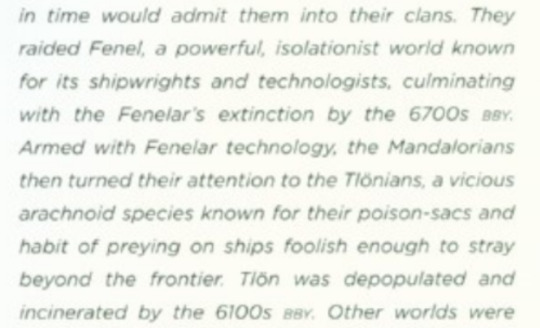
[Mandalorians] raided Fenel, a powerful, isolationist world known for its shipwrights and technologists, culminating with the Fenelar’s extinction by the 6700s BBY. Armed with Fenelar technology, the Mandalorians then turned their attention to the Tlӧnians, a vicious arachnoid species known for their poison-sacs na habit of preying on ships foolish enough to stray beyond the frontier. Tlӧn was depopulated and incinerated by the 6100’s BBY.
but also adds:
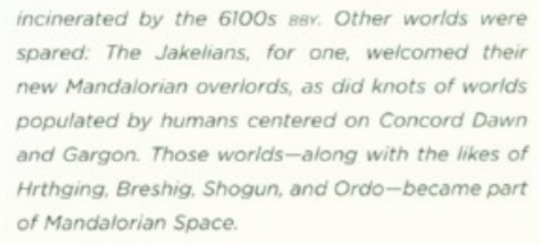
Other words were spared: The Jakelians, for one, welcomed their new Mandalorian overlords, as did knots of worlds populated by humans centered on Concord Dawn and Gargon. Those worlds - along with the likes of Hrthging, Breshig, Shogun, and Ordo - became part of Mandalorian Space.
While again, claiming that during Mandalore the Ultimate’s rule:
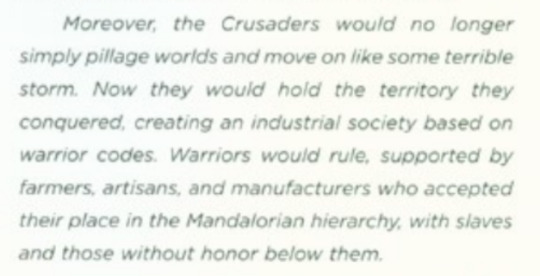
[...] the Crusaders would no longer simply pillage worlds and move on like some terrible storm. Now they would hold territory they conquered, creating an industrial society based on warrior codes. Warriors would rule, supported by farmers, artisans, and manufacturers who accepted their place in the Mandalorian hierarchy, with slaves and those without the honor below them.
This creates a potential conflict with the older lore, as Mandalorian warriors (Taungs) were prone to destroying encountered species, holding in respect only those as brave and mighty as themselves. Why in times before Mandalore the Ultimate, would they spare those who willingly give up on their independence? Why would they even bother to be overlords, when ancient Mandalorians were nomads, travelling from one world to another? Cassus Fett, a right-hand of Mandalore the Ultimate even called this the “nomad’s curse” [Knights of the Old Republic comics series, issue #23, 2007]:
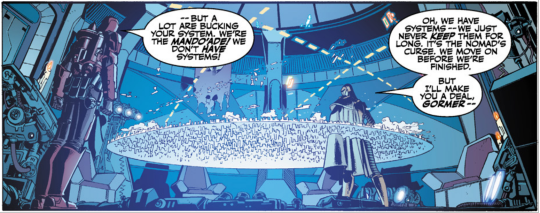
Gormer: [...] We’re the Mando’ade! We don’t have systems? Cassus Fett: Oh, we have systems -- we just never keep them for long. It’s the nomad’s curse. We move on before we’re finished.
Of course, agricultural planets like Concord Dawn could be useful for providing food and other needed goods or services to their overlords, as a sort of tribute which in return could allow warriors to focus on honing their battle skills without worry for mundane tasks. The problem again lies in the nomadic ways of ancient Mandalorians (Taungs), as we need to remember that A) space travelling was much more primitive and limited than in modern times and B) the crusades took the warriors into far corners of the galaxy for long periods of time, and they needed a secured access to provisions. Which raises a question about the logistic nature of transporting large food supplies far away beyond Mandalorian Space and if it would not be easier for Crusaders (Taungs) to simply take the needed goods from conquered worlds (as author himself noted!) than rely on their human subjects? If people of Concord Dawn or other conquered worlds travelled with their masters, some could adapt the warrior culture as their own though officially non-Taungs were allowed to join Mandalorian ranks as equals under Mandalore the Ultimate’s rule. If Crusaders did not stay too long on one planet, would people of conquered worlds have time to fully understand their religion, culture and custom to become a reliable source of knowledge for the Republic?
If indeed before Mandalorian Wars, Crusaders (Taungs) spared some planets from destruction and ruled over the human populace, we may assume their social structures were more complex than it is believed to be. The division between warriors - lords - and the subjected population could also influence Mandalorian religion. If Kad Ha’rangir was the main deity of Mandalorian Crusaders, then those who did not pursue warrior’s life and continued to be farmers, miners, blacksmiths or fulfill any other mundane occupation, the Arasuum’s “idle consumption” may be redirected on the lower part of society now. In that sense, a warrior successfully tempted by Arasuum would give up on fighting, settle down and become a farmer themselves, losing the high social position.
Another thing that differs from the mentioned History of the Mandalorians is the claim that Taungs-early Mandalorians served one god (Kad Ha’rangir)[1] and waging wars was a necessary act to defy Arasuum. Which suggests that Arasuum’s power over Mandalorians was believed to be a real danger, if warriors needed to prove their worth in Kad Ha’rangir’s eyes. Frankly, this religious division reminds me more of god vs satan-tempter dynamic than any ancient religion, albeit with an ironic twist, as the “good god” is called the Destructor while the “tempting to evil” deity is connected to peace and idle consumption. Looking at our real-life geopolitical situation, I imagine a great number of people would actually want to fall under Arasuum’s rule to finally have some sense of stability and prosperity. Which on one hand illustrates well how different the morality of Mandalorian Crusaders was from our real world and in-universe Republic. However this academic text demonizes Arasuum, in the sense, his status of god is not acknowledged as he plays more the role of “devil”. In contrast, the History of the Mandalorians paints a different picture, one in which early Mandalorians (Taungs) saw "war as a ritual form of worship to Mandalorian gods". Understandably, said gods were not named yet, but if we agree this statement now includes Kad Ha’rangir and Arasuum, we could assume that latter played a more vital role than just being the enemy - especially since he was part of Creation Tale known as Akaanati’kar’oya (The War of Life and Death), mentioned by Mandalorians: People and Culture. If a war was seen as a ritual form of worship and ancient Mandalorians interpreted the myths as literal supernaturalism (as stated by Mandalorians: People and Culture), then any battle could be seen by ancient Crusaders as symbolic reenactment of events from a well-known myth. Thus Arasuum would be an important figure no less than Destructor himself. Because if Kad Ha’rangir identifies life, then Arasuum logically should represent death. Which fits what Canderous Ordo said in Knights of the Old Republic game (2003) when prompted by the player:
Player: The Mandalorians destroy worlds for honor? Canderous: Win or lose, as long as the fight is worthy, then honor is gained. The glory at having triumphed over impossible odds is what drives us. If there's nothing at stake – your possessions, your life, your world – then the battle's meaningless. We Mandalore take everything we are and throw it into battle. It's the true test of yourself – the battle against death… against oblivion.
or
Player: You seek death? Canderous: All life dies eventually. A true warrior is one who can beat it down whenever it raises its head. But…
or
Player: Then what are you doing now? Canderous: The days of combat and glory and cheating death at every turn seem to be over now… I take what I can.
Again, the “stagnation and idle consumption” could be treated literally or could be a metaphor for unchanging death and the “peaceful homestead” offered in afterlife. Additionally, since “Industry. Honor. Savagery: Shaping the Mandalorian Soul” in-universe was presented in 24 ABY but Death Watch Manifesto (included in Boba Fett’s Files) fell officially into Rebels’ hand after bounty hunter ended in Sarlacc’s pit, as was seen in The Return of Jedi (4 ABY). An official rapport mention that Fett’s personal items found on Slave I were “examined prior to archiving"
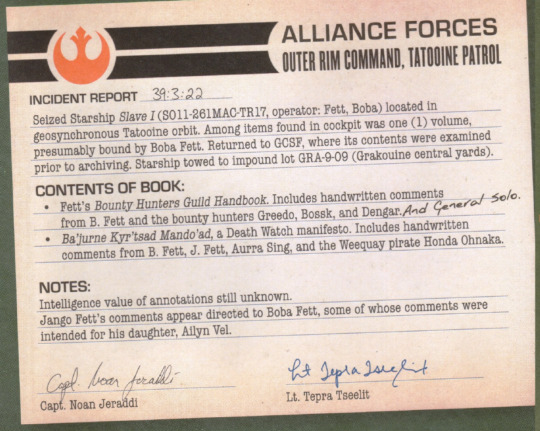
so we can’t cross out the possibility that once the Empire fell and the Rebellion transformed into the New Republic, historians and researchers got access to those files. Thus there is a chance the “Industry. Honor. Savagery: Shaping the Mandalorian Soul” represents a take on Arasuum influenced by Death Watch Manifesto - about which I will talk more soon.
Another paragraph important to our understanding of Mandalorian religion mentioned shift in perception of gods:
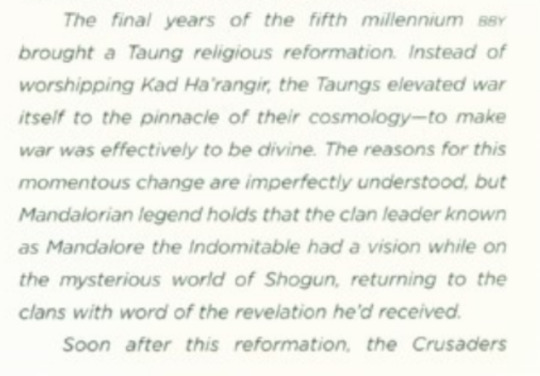

“The final years of the fifth millennium BBY brought a Taung religious reformation. Instead of worshipping Kad Ha’rangir, the Taungs elevated war itself as to the pinnacle of their cosmology - to make a war was effectively to be divine. The reasons for this momentous change are imperfectly understood, but Mandalorian legend holds that the clan leader known as Mandalore the Indomitable had a vision while on the mysterious world Shogun, returning to the clan with world of the revelation he’d received. Soon after this reformation, the Crusaders raided the galaxy’s central systems. In 4024 BBY they attacked the planet Nevoota in the Colonies, exterminating its species during a three-year campaign.”
One one hand, as a source author lists a Mandalorian legend - although that alone does not provide a historical context[2] of when said legend originated. Is this an ancient source preserved in written or electronic form? Or some folklore tale passed through generations and growing in additional details alongside? One way or another, we are provided an example that Mandalorian religion A) was not a stagnant matter and B) the important change influenced the warrior society and C) most of Republic knowledge about Mandalorian Crusaders comes from times after the reformation (The Sith War, Mandalorian Wars and forward) but as author pointed out, the “reasons for this momentous change are imperfectly understood”. Which suggests that the Republic academic environment has limited understanding of Taung mentality.
It would definitely help if the author provided more sources on which this academic lecture was based on. At the same time, all the deviations from widely understood lore can be easily explained as the author's limited knowledge due to factors beyond the control of scholars (destroyed or fragmentary sources, growth of legends around ancient events, impossibility of verifying data). The society of Taung (ancient Crusaders) is much more complex and if indeed they kept conquered worlds like Concord Dawn in which farmers were supporting the ruling caste of warriors, this experience may influence their religious understanding of Arasuum’s idle consumption and laziness.
Bounty Hunter Code: From The Files of Boba Fett was co-written by Daniel Wallace, Ryder Windham and Jason Fry. Similarly to The Jedi Path: A Manual for Students of the Force (2010), Book of Sith: Secrets from the Dark Side (2012) and Imperial Handbook: A Commander's Guide (2014) this is a reference book presenting events from the perspective of characters and not an all-knowing narrator. Each book also contains additional notes written by certain characters who at some point read it and for this or another reason were motivated to add their own commentary. What provided us both the in-universe knowledge and often a counterargument coming from a different “point of view”.
Death Watch Manifesto, in mandalorian language known as Ba'jurne Kyr'tsad, is supposedly written by Tor Vizsla. As author claimed, the content of the Manifesto was meant for Death Watch members chosen among other things to train and educate recruits:

You are reading this because you have been chosen as a Rally Master, charged with training recruits, preparing Watchers for operations and commanding them in battle. Like Cassus Fett's Rally Masters of ancient times, you must educate and inspire our warriors, so they understand their heritage and will sacrifice their lives for it."
The Ba'jurne Kyr'tsad at some unspecified point of time fell into Jango Fett’s hands and was passed down to his son, Boba (thus included into titular files of Boba Fett). Jango himself questioned the authenticity of the author:

I wonder if Vizsla really wrote this. He was a thug. Sounds more like Priest, or Reau. Maybe the younger Vizsla. That one likes speeches - JANGO
But as Fett noted down the Manifesto sounds as something certain Mandalorians could say. Going so far to name Pre Vizsla, Isabet Rau or Dread Priest as examples and two of those mentioned characters were working for him as Mandalorian Training Sergeants on Kamino. So whoever the author truly was, we have no reason to doubt the Death Watch Manifesto was written by Mandalorian for Mandalorians and the presented here political statement could be even shared beyond the Death Watch group. We also have a rough time frame for better analysing the source - it was written after the Battle of Galidraan (44 BBY) and if Tor Vizsla indeed was the author, before his death in 42 BBY.
As was already said in “Kad Ha’rangir and Mandalorian traditional weapons, part 2”, analysing Ba'jurne Kyr'tsad is not an easy task, as we need to tread between historical data and the author's subjective opinion. Among other things, author described repression that happened upon the traditionalists, such like exile to Concordia and intentional destruction of their culture:
“Seven centuries ago, their craven, hut’uune warships and Jedi bombarded our worlds. They incinerated Mandalore’s farmland and forests, leaving much of our homeworld a forsaken desert of fine white sand, and then occupied our worlds. They killed, exiled, or disarmed our warriors and suppressed our ancient codes.
or
“Our secret operations on Mandalore and Concordia are producing more and more beskar, but Mandalorian armor remains hard to find - and the New Mandalorians treacherously destroyed many heirloom suits of beskar’gam.”
and
“Some of our warriors were exiled to the moon Concordia. Others - myself included - slipped away to resume the ba’slan shev’la”.
If we agree it’s true that the warrior culture was systematically erased for centuries within Mandalorian society[3], then we must ask a question: how truthfully is the knowledge provided by the author? [4]
Our best chance to determine how well information is presented here, is to look at additional commentary provided by Jango Fett. Mentioned above Jango’s comment was written on the margin of the fifth page (sixth, if we count the author's introduction as starting point) and was his first note addressing the content of presented text. The manifesto was written with a certain political message - thus with no doubt is not an objective source material - yet a great chunk of the information up to this moment is about Mandalorian history and culture from ancient to modern times. Fett did not polemize with historical knowledge contained in the book while most of his comments are in fact about Jaster Mereel (modern times), weapons or remarks about Tor Vizsla and Death Watch. So either, Jango
had no sufficient knowledge about the ancient times to question author’s claims
did not notice anything suspicion in provided data
didn’t care about the history aspect thus did not bother to comment on it.
Although Jango was not a fan of reading, he was raised by Jaster Mereel, the leader of True Mandalorians whom Montross accused of forgetting Fett was not his son. As we know from various sources, both True Mandalorians and Death Watch were once part of the same Mandalorian Mercs group, so if historical knowledge was passed between warriors, then Jango had a great chance to learn it from Mandalorians (Jaster) who took him into their ranks when he lost his biological family. As Fett did not critique the historical data provided by author and even commented the arguments and/or rhetoric sounds more like something his own people may say than Tor Vizsla (whom he considered to be just a thug), I think it is safe to assume the historical knowledge of Death Watch is similar to those passed down within True Mandalorians.
Thus for the lack of proper counterarguments, I will assume the historical aspect of Ba'jurne Kyr'tsad reflects the knowledge of modern Mandalorian warriors. Establishing that, let’s take a closer look at the Arasuum and Mandalorian religion.
One of the most important things in which Ba'jurne Kyr'tsad differs from Mandalorians: People and Culture is the certainty about Mandalorians’ origins. Here, there is no doubt about the connection between modern culture and the now-extinct Taungs, whom the author calls his people’s ancestors even if they have never shared the same blood.
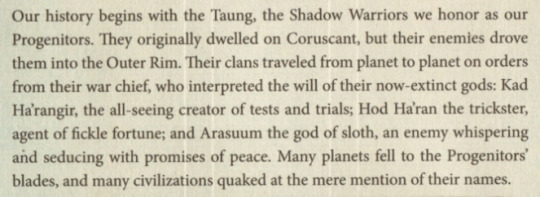
THE TRUE HISTORY OF THE MANDALORIANS Our history begins with the Taung, the Shadow Warriors we honor as our Progenitors. They originally dwelled on Coruscant, but their enemies drove them into the Outer Rim. Their clans traveled from planet to planet on orders from their war chief, who interpreted the will of their now-extinct gods: Kad Ha’rangir, the all-seeing creator of tests and trials; Hod Ha’ran the trickster, agent of fickle fortune, and Arasuum the god of sloth, an enemy whispering and seducing with promises of peace [...].
Author pointed out the religious nature of Taung and later, early Mandalorian culture (supported by various tie-in source material) in which the war chief interpreted the will of gods. Interestingly, all three main deities known to us - Kad Ha’rangir, Hod Ha’ran and Arasuum were included as those influencing the life of ancient Mandalorians.
The additional graphic presenting said gods adds that “ancient Mandalorian deities were led by the all-seeing Kad Ha’rangir”, so although there was hierarchy between gods, Arasuum is part of the pantheon and not a minor god himself [5].
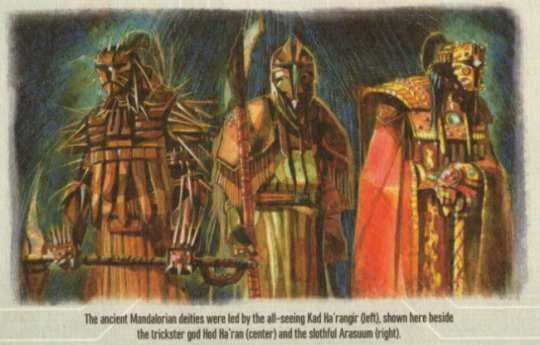
Arasuum is here called the “enemy whispering and seducing with promises of peace” but considering how the author segregates Mandalorians into two categories: the “faithful” followers of old (warrior) traditions and “faithless” who rejected it, we should ask: is this an accurate mythology role the god fulfilled in the ancient times, or is it solely the author's political allegory reflecting the conflict between Death Watch and New Mandalorians?
As was mentioned before, Death Watch Manifesto is as much about passing knowledge to their members as upholding a specific ideology. So on one hand, we have an old symbol of Crusaders that author described as:

The ancient symbol of the Mandalorian Crusaders is a ring adorned with shape points. The points represent the weapons of warriors, while the ring symbolizes the cycles that govern life - birth and death, conquest and defeat, and the promise that new warriors will arise to carry the traditions of the departed.
If the ancient Mandalorians (Taung) believed life is a cycle, in which birth and death, conquest and defeat follow each other, then logically war and peace were inextricably linked too - even if the time between “official” wars against Republic or Sith was used for preparation for another attack, as happened after The Sith War (rebuilding forces under Mandalore The Ultimate) and after Mandalorian Wars (Canderous Ordo’s Mandalorian Outpost on Dxun).
Looking at the mando’a language, the term of “peace” has connection to words like “healing” and “rest”,
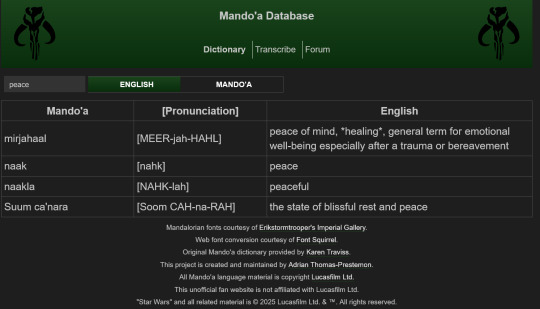
while the Mandalorians: People and Culture mentioned a “permanent, peaceful homestead” located in traditional afterlife, in which wives and children were living[6], defended by warriors who joined the army of the dead. So we could draw a connection between the ancient Mandalorian concept of peace, healing, and even “permanent” resting (death).
If Arasuum originally was the god of death, then “seducing with promises of peace” could as well be a metaphor for giving up on life. In that sense the epithet of “god of sloth” makes sense, as being Mandalorian meant constantly facing danger and hardship and overcoming the odds. Thus those who lost their will to fight (staying alive) could be considered by the community as “lazy”.
At the same time, the short description of Mandalorian gods mentioned Hod Ha’ran as the trickster, yet the author completely omits his role. All the “tricking” is moved on Arasuum alone. And so according to author, the deity seduces Mandalorians “with promises of peace” or in general the unfortunately for Mandalorians ages are assigned to happen under Arasuum’s rule:

After Ani’la Akaan, weak Mandalores led the clans, and our honor ebbed - these were the years of Arasuum, The Stagnation.
Unsurprisingly, author attributes Arasuum’s negative traits to Republic, Jedi and New Mandalorians:

The Annihilation birthed the evils we now fight against. To rule us, the Republic installed puppets who had sought a foolish peace with the Senators and their Jedi. In the centuries since the Annihilation, this line of Anti-Mandalores - leaders of the self-styled New Mandalorians - have forfeited our honor, buying us soft lives of sloth and dependence. Weary of war and deluded by lies, many of the Mando’ade accepted the Anti-Mandalores and the illegitimate rule of the Faithless, as we call the New Mandalorians.
or

Meanwhile, centuries of New Mandalorian lies had left the Mando’ade weak and soft. One of my kinswomen, the Duchess Satine Kryze, had been sent offworld as a child by her father, a mighty clan warlord, and she fell prey to the lies of the Jedi. After her father perished in the Great Clan Wars, she betrayed his memory by becoming the leader of the New Mandalorians. Aided by Jedi tricks, she became the newest Anti-Mandalore, whereupon the exhausted Mando’ade flocked to her banner.
Adding to this all paragraphs mentioning how the Faithfull Mando’ade faced and overcame hardship (deliberate destruction of warrior culture) that made them stronger, there is no doubt that the author is using extinct gods as metaphor for political conflict: the Mandalorians keeping old faith are those tested by Kad Ha’rangir, those accepting pacifism are deluded by lies of Arasuum[7].
Thus Death Watch Manifesto can’t be treated as an objective source on which we could base the reconstruction of an extinct religion. On one hand, modern Mandalorians must be somehow aware of who Kad Ha’rangir and Arasuum were to read between the lines of what the author is trying to imply here. On another note, the short introduction at the beginning of Ba'jurne Kyr'tsad may be what the ancient gods were already reduced to - a symbol in the centuries old fight between two opposite ideologies. At the same time, it supports Mandalorians: People and Culture’s claim how modern Mandalorians treat old mythology “as parables to illustrate a deeper philosophical meaning rather than literal supernaturalism”.
As was mentioned before, there is a chance that Ba'jurne Kyr'tsad became available as a historical source for academic use. Thus could influence how modern (post-Empire) scholars interpret ancient culture of Mandalorian Crusaders.
After examining three different sources - Mandalorians: People and Culture (handy guide), Excerpted from “Industry. Honor. Savagery: Shaping the Mandalorian Soul” (in-universe academic text) and Ba'jurne Kyr'tsad (in-universe half guide, half political manifesto) our knowledge about religion of Taung-ancient Crusaders is still limited to the point, it is hard to tell for sure what is an accurate knowledge and what is modern reinterpretation of old myths.
Because of that, the next part will focus on widely understood Mandalorian culture and what the characters and narrative can tell us about the original warrior religious dogmas.
SIDENOTES
[1] Additionally, The Essential Guide to Warfare includes an in-universe translation of the best-known section of Dha Werda Verda that presents the ancient battle between the Zhell and the Taungs. Here it is revealed that pre-Mandalorian society of Taungs believed in supernatural being called Maker, which may be a totally different deity than Kad Ha’rangir. Or alternatively, the Maker has evolved into Kad Ha’rangir.
[2] Source material doesn’t agree when the religious reformation happened. The Essential Guide to Warfare attributes the change to Mandalore the Indomitable, while The Old Republic’s lore entry suggests it happened before said leader rose in power.
The Old Republic game’s Galactic History 42: The Nevoota Extinction codex Lore Entry: This datacron holds unheard of power and knowledge collected by an ancient race. You access its power and discover writings which are clearly only one small piece of a massive galactic history: Some years before the Old Sith Wars, the Nevoota–a species of insectoid aliens from the Balmorra system–found themselves facing an army of disciplined warriors in distinctive armor. The warriors were Mandalorian Crusaders, testing themselves against the galaxy’s deadliest species. However, the Nevoota were a challenge even for the Mandalorians. Possessing superior numbers and utterly disdainful of death, the Nevoota fought a four-year campaign under the cunning warlord Ithcharaka–but finally the Mandalorians hunted the Nevoota to extinction. This conflict had a profound effect on Mandalorian culture. The Mandalorians began to see war itself as an end, not just a means of conquest. Through war, Mandalorian society found its highest expression. When Mandalore the Indomitable eventually rose to power, he led a people who demanded nothing less than the greatest challenges the galaxy could offer.
[3] Repression aimed at warriors were implied by The Clone Wars: The Mandalore Plot episode, in which Prime Minister assured Obi-Wan Kenobi that their warriors were exiled and died out decades ago:
Almec: I welcome you as a servant of the people, but I am troubled by the false rumors that brought you here. Mandalore would never turn against the Republic. The Duchess Satine values peace more than her own life. Kenobi: I'm aware of the Duchess' views. Almec: Master Kenobi, Mandalore's violent past is behind us. All of our warriors were exiled to our moon, Concordia. They died out years ago.
[4] According to Ba'jurne Kyr'tsad, the ancient tradition was passed in secret for ~700 years to uphold customs that warriors should consider sacred. Logically then, after such a long time Tor Vizsla or whoever wrote the Manifesto under that name may simply repeat already whitewashed “history lessons” that for ages fitted “Faithfuls’” needs. In that case the author himself may not lie on purpose and simply presents the incomplete or twisted knowledge passed through generations between traditional Mandalorians.
At the same time there is the possibility that the author deliberately presents information in a way that fits the Death Watch’s rhetoric to manipulate/encourage readers to his case. This doesn’t automatically mean the author is lying about events per se, as the Sith War, Mandalorian Wars and Republic attack on Mandalore did happen and have confirmation in different sources, however the manner of presenting is clearly non-objective.
Of course, those two options don’t exclude each other and may easily co-exist, as the author operates on knowledge passed down to him while presenting it in a favorable way to supporters of Death Watch.
[5] The importance of Arasuum is supported by the Creation Tale known as Akaanati’kar’oya (The War of Life and Death), mentioned by Mandalorians: People and Culture.
Additionally, Arasuum was presented on the picture in the outfit looking the richest of all Mandalorian deities; the red cloak, golden-like plates with some gems brings to mind luxury that ancient Taung and Mandalorians didn’t seek or hold in great regard. But if this deity represents “idle consumption” and sloth, we should ask, how did he become so rich in the first place? This reminds me how some real-life chthonic deities connected to death and underground like Greek Hades or Slavic Veles had also strong ties to prosperity and wealth. As beskar is the most important Mandalorian wealth, I wonder if there could be a link between beskar and the potential deity of death, if Death Watch Manifesto mentioned the concept of non-Taung vassals who were serving Mandalorian clans as metalsmiths. The blacksmith knowledge was held in high regard and was one of the most well guarded secrets, so one’s skills could be respected (and well-paid?) while the person in question didn’t need to be warrior.
[6] As I mentioned in previous part, the traditional afterlife’s gender division doesn’t fit what we know about Taungs and early Mandalorians, however author of Ba'jurne Kyr'tsad provided insight into old social structures, in which Mandalorian warriors were supported by vassals responsible for various tasks, like blacksmithing:
The Progenitors saw hand-to-hand combat as the warrior’s highest calling. Their helmets resembled their own faces, and each suit was custom-made for its wearer, with the armor of venerated ancestors melted down and reforged to equip a particularly valorous war chief or clan leader. Some forged their own armor, while others left that task to metalsmiths serving their clans as vassals.
or
Under the Uniter and strong Mandalores who followed him, our homeworld became the protector of many star systems and the center of an honorable civilization. Warriors ruled, protecting the artisans, manufacturers, and laborers who supported them and who were supported in turn by vassals and servants.
So maybe the traditional afterlife was not divided by gender and age in which women and children were delegated to peaceful homestead but into souls representing warriors and non-warriors? The first continued their fight as part of the army of dead. The letter, like ancient vassals, supported said army by providing food (farmers), armors (blacksmiths) among other things?
[7] This way the author can critique the “faithless” Mandalorians without actually demonizing them - they aren’t bad Mandalorians, but ones “seduced” by the Arasuum’s promises of peace and sloth. Which makes sense, as the author himself noted how divided is the modern mandalorian society.
This division between the Faithful and the Faithless split every clan: members of the Ordos, Fetts, Kryzes, Awauds, Priests, Gedycs, and yes, Vizslas belonged to both sides in our long struggle.
#star wars#arasuum#kad ha'rangir#cienie's take on mandalorian culture#mandalorians#mandalorian culture#mandalorian religion#taung#ancient mandalorians#cienie's meta
8 notes
·
View notes
Text
Wanting to draw my Taung/human hybrid revan but sick as hell right now
1 note
·
View note
Note
An eclipse would hold a significant cultural importance because of "Maker comes to unmake" and the battle against Zhell under darkness of presumed volcano eruption.
I imagine Orthodox families devoting the total eclipse time to pray to Kad Harangir.
aww shit, ummmmmm mandalorian holidays?
Ooh. something I haven't thought much about, honestly, lmao. so bear with me as i completely 100% make stuff up lkasdjflkjasd galactic calendars are absolute Hell and mandalore doesn't abide by anyone elses rules so they do their own thing; apparently canonically mandalore's orbit is 366 days (boring) but the day is 19 hours (not boring!)
because the word for ten is two-fives i'm going to say five is an important number and that years are grouped into fives. there's some kind of big sort of 'yule' or 'new year' holiday at the end of every fifth year
also: mandalore, geographically, is apparently two-third's the diameter of Earth; however, Concordia is obviously fucking Massive if it has a breathable atmosphere, meaning Solar Eclipses are probably pretty common and could conceivably cover the whole damn planet every time they happen. so, there's like a mandalorian holiday every time there's an eclipse where you just bugger off to cook with family and don't have to go to work, and watch the eclipse with the kiddos (i'm not going to think about how absolutely insane mandalore's tides were before the oceans got boiled off).
Mandalore *used* to have pretty dramatic seasons (re: somehow being subtropical in many areas and having absolutely Bitter winters in the north and south) until the Dral'han, so seasonal holidays still exist even if they're a lot Less important than they used to be. Harvest festivals are a thing in like every culture and mandalorians are no exception - they're just a lot Bigger of a deal in places like Concord Dawn where most people are farmers asdklfjsdl
I imagine there's several holidays that maybe the NM tried to ignore a little bit re: celebrating the return of warriors after notable crusades or wars, wherein people are supposed to visit family maybe? just called various Homecomings
the date of the Dral'han and the date of the battle of Malachor V are probably pretty dour 'holidays', days of mourning etc. days where you recite your Rememberances in their entireties (tho you maybe should be doing it a lot more frequently than that lol), share stories from those past, etc. I can't decide if it would be good or bad luck to have a child born on one of those days but it's Some Kind of Luck or portent for their future birthdays are less important, but i'm sure after a successful verd'goten and the kid and mentors and whatnot get home it's a big Family Bash, passing the kid around to look at their shiny new armor lmao
there you go some stuff i pulled out of my butt
#bo speaks#mandoblogging#mandalorians#mandalorian culture#headcanon#star wars headcanon#kad harangir#hod haran#arasuum#eclipse#star wars#mando'ad#manda'yaim#Concordia#mandalorian religion#zhell#taung#mando'a#mando'ade#mandalorian language#mandoa#mandalorian
63 notes
·
View notes
Text

Mandalorian Neo-Crusader Aliens. For a lore video I made: https://youtu.be/ib4O8yBRoTo
From left to right:
Mandalorian Crusader, a Taung
Mandalorian Neo-Crusader Warrior, a Wookiee
Neo-Crusader Rally Master, a Mandallian Giant
Neo-Crusader Marshal, a Human
Neo-Crusader Veteran, a Mon Calamari
Neo-Crusader Shock Trooper, a Whipid
#star wars#pixel art#fanart#mandalore#mandalorians#sw legends#mandalorian culture#taung#wookiees#mon calamari
12 notes
·
View notes
Text
The Mandalorian Proletarian Uprising
Disclaimer: this post is 100% headcanons. I support your fandom-ordained right to make whatever kinds of headcanons and interpretations you want, even if they annoy me. That being said… I have some of my own.
You know how there’s a fraction of fandom who hold that the Old Mandalorians were a warrior elite who were oppressing the masses, and the New Mandalorians were the people rising up against their overlords? At least I’ve been getting those posts on my dash.
And at first I was annoyed, because that’s mushing together two completely different periods of Mandalorian history. And I have a half-written essay in my drafts about the demographics of historical warrior societies and how Mandalorians aren’t all warriors, actually.
But then I changed my mind. Because you know what? The Taung do seem to have been exactly the kind of bastards who committed several genocides and enslaved entire planets to their war machinery, either as soldiers or for churning out weapons and ships in factories. And yes, they do seem to have held that only Mandalorians had real souls. And that one had to be a warrior in order to be a Mandalorian, and the plebs aren’t mentioned. Which absolutely does make it seem like they were an oppressed and possibly (probably) an enslaved class.
So instead of brushing all that under the rug and crying about how my favourite blorbos aren’t imperialist assholes acshually, let’s say all that bad stuff happened. Let’s engage with it. Because there could be an interesting story here—good stories are all about conflict, after all.
So when did the people rise up?
So the first question is to ask when. And this is the part where I’m going to swerve left from the narrative I presented at the beginning of this essay. Because those genocidal warrior elites that annoy some fans? They were Taung. Who went extinct near four millennia ago. So that rather pushes back the date of our uprising.
Unfortunately it doesn’t seem like the masses rose against their evil overlords during the heyday of the Taung—they seem to have been going strong right up to the Battle of Malachor V, after which they are supposed to have gone extinct.
But then I remembered this little aside in this other headcanon essay of mine (which is also a good background to my headcanons):
As an aside: do you think the Mandalorians had a civil war afterwards? Now that these armies non-Taung Mandalorian warriors settle on Mandalorian worlds, where the previous non-Taung populations were little more than slaves? Did they fight it out or did they open up the clans again, for anyone willing to join?
So what if they did fight it out? Imagine this:
The Mandalorian Uprising after the Battle of Malachor V
The aftermath of the Battle of Malachor V is said to have been 300 years of diaspora and disarray for the Mandalorians. Let’s imagine what might have happened during those years:
The Mandalorian Empire has swept through the galaxy, gobbling up worlds and turning them into cogs for its hungry war machinery. Citizens of conquered worlds have two choices: join the Mandalorian armies or become a slave in their factories churning out ships, weapons, and munitions. The first option is presented as a chance to become a Mandalorian warrior yourself, to become one of the elites and find fame and glory and gold on the battlefields. The truth is that most of the press-ganged soldiers are little more than canon fodder.
The Mandalorian plague has seemed like an unstoppable tide, but suddenly Malachor V happens. Entire Mandalorian fleets have been vaporised, along with the Mand’alor himself and his top brass. The tide turns. The Mandalorian succession is in the air; their leadership in disarray. The Republic starts swiftly taking back the recently conquered worlds. The Mandalorian armies splinter.
And now many soldiers leave to find their fortunes among the wider Galaxy. But more of those ragged armies limp back to the Mandalorian home worlds and what territories they can keep a hold of. And now they try to settle down to governing them, according to their ancient laws and practices.
Only during the Mandalorian wars, the Mandalorian armies have grown exponentially. And they were grown almost entirely from the non-Taung populations. At the start of the war, clear majority of Mandalore’s citizens were Taung. At the end of it, they’re a small minority.
Many newly-minted Mandalorian warriors do buy into the warrior elite’s way of life—it benefits them, after all. But there are still huge tensions between the wish to return to the ancient ways of the Taung and the need to change how their society works in order to adapt to their completely different demographics. And maybe that tension holds for a while, maybe even decades. But eventually it snaps and a civil war boils over, because the warrior elite—now a small minority—cannot suppress their conquered masses forever.
And maybe that’s another reason why the Taung went extinct. They can’t have been all present at Malachor V, so I’ve previously suggested that they were effectively absorbed into the population, until a multitude could claim Taung ancestry, but there were no pureblooded Taung left. But maybe that extinction was helped along by the guillotine à la French Revolution. Maybe their oppressed subjects finished the job.
And unfortunately—like is often the case—it’s not just a single civil war. Like is won’t to happen, many people try to climb to the top and become the new king to replace the old one. So for decades or centuries, the Mandalorians suffer intermittent power grabs and uprisings, until they eventually settle on a new form of life and government.
Effects on Mandalorian culture
So why didn’t the Mandalorian culture go extinct? A large part of that is because the oppressed people, after throwing down their oppressors, adopted their customs as a mark of their new station in society. For better or worse, they too have been living in Mandalorian society and those are the customs of the free elites they know. If their own customs have been sufficiently suppressed, it might be only culture they know. This is not unusual if you look at irl history either.
Another part is that large parts of the Mandalorian armies (the cannon fodder) joined in on the fight. And many of them had been living as Mandalorian soldiers for years or even decades. It is their way of life too now, for better or worse.
The Mandalorian culture survives, but it is completely transformed. Anyone can be a Mandalorian now, regardless of blood. The old gods are abandoned in favour of belief in shared oversoul. Old philosophies and values are reinterpreted, and conquest is abandoned in favour of survival.
One of my favourite fanons is that Mandalorians have an abiding hatred for slavery. But I never knew how to justify it. And this here could be where it started—this slave revolution on Mandalore. Henceforth no Mandalorian would ever be a slave again.
And this could also help explain one of the dichotomies of the Mandalorians: how are they such consummate soldiers, yet have such problems with being governed? And this could be where the ethos of accepting no overlords could have been born. Mandalorians know having a tighter chain of command would make them more effective—but they also know what it would cost. And they would never take that bargain. It’s forged into the very soul of their national ethos, just like liberté, égalité, fraternité is forged into the French: Vode An.
Vode An makes for such a good working class motto, doesn’t it?
tldr:
Yes to Mandalorian peasant uprising against their warrior-elite overlords. But make it happen after the Mandalorian Wars, not in the modern days. Although you could certainly still see some ripple effects, internal tensions and biases to this day; just look at USAmericans, slavery and racism.
As always, this is just one possible way things could have gone down (and of course there can be more than one civil war in a people’s history). But I rather like it because it could explain some of those seemingly incongruous parts of the Mandalorian culture.
#mandalorian headcanons#the taung were jerks actually: the essay#blanket permission#mandalorian history#mandalorian culture#meta: mandalorians#mandalorians
23 notes
·
View notes
Text

The Taung child, a young Australopithecus found in a fossilized eagle's nest, here illustrated by Ettore Mazza.
4 notes
·
View notes
Text
yeah, the good folks of stewjon have blood that tastes like:
windex and cough syrup
and it is:
toxic for many species to consume
because:
there once was a species of predatory birds who would pick up their ancestors and drop them from 500 ft up like a crow does to a walnut
#BEHOLD the evolution of man#they taste ass nasty#these birds existed until the taung came and massacred them which is the ONE thing the locals didn't mind#stewjon lore tag
6 notes
·
View notes
Text

I learned about the Taung child , an Australopithecus Africanus child found in the Taung region of South Africa. The Taung are also ancient primates and culture in Star War. I do enjoy the relatively obscure source for Star Wars inspiration.
13 notes
·
View notes
Text

Ubicado en la cima de un volcán, a 1,518 metros sobre el nivel del mar, Taung Kalat es considerado uno de los templos más remotos del mundo y un patrimonio cultural de Myanmar.
12 notes
·
View notes